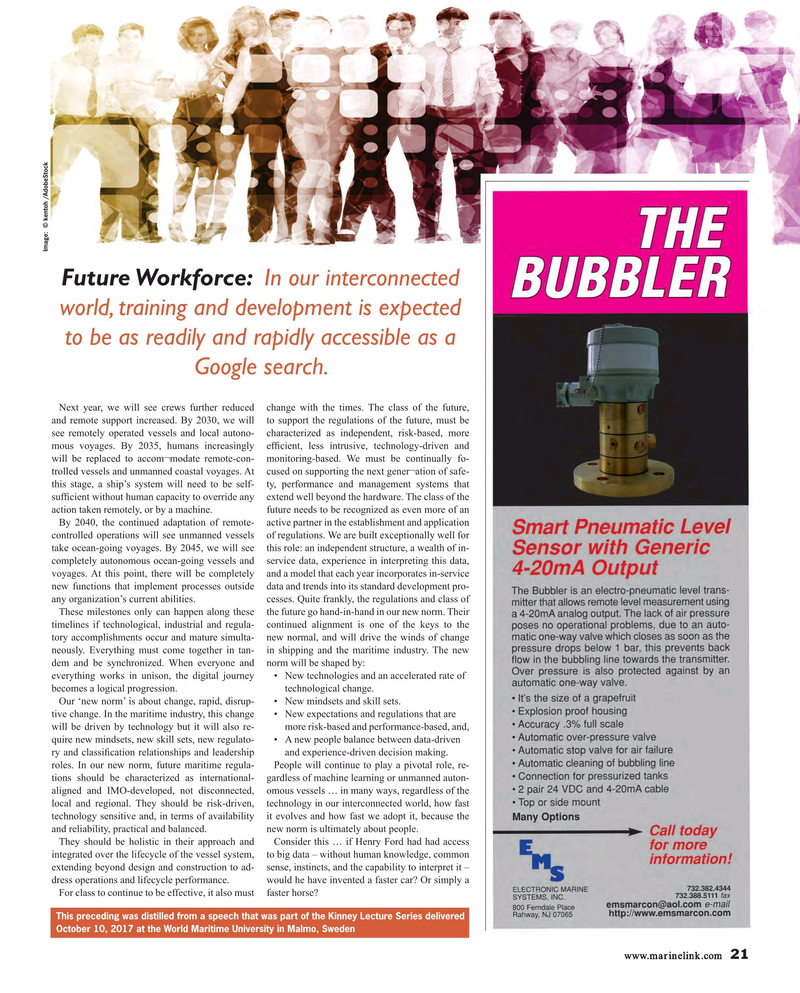
Page 21: of Maritime Reporter Magazine (December 2017)
U.S. Navy Quarterly
Read this page in Pdf, Flash or Html5 edition of December 2017 Maritime Reporter Magazine
Image: © kentoh /AdobeStock
Future Workforce: In our interconnected world, training and development is expected to be as readily and rapidly accessible as a
Google search.
Next year, we will see crews further reduced change with the times. The class of the future, and remote support increased. By 2030, we will to support the regulations of the future, must be see remotely operated vessels and local autono- characterized as independent, risk-based, more mous voyages. By 2035, humans increasingly ef? cient, less intrusive, technology-driven and will be replaced to accom¬modate remote-con- monitoring-based. We must be continually fo- trolled vessels and unmanned coastal voyages. At cused on supporting the next gener¬ation of safe- this stage, a ship’s system will need to be self- ty, performance and management systems that suf? cient without human capacity to override any extend well beyond the hardware. The class of the action taken remotely, or by a machine. future needs to be recognized as even more of an
By 2040, the continued adaptation of remote- active partner in the establishment and application controlled operations will see unmanned vessels of regulations. We are built exceptionally well for take ocean-going voyages. By 2045, we will see this role: an independent structure, a wealth of in- completely autonomous ocean-going vessels and service data, experience in interpreting this data, voyages. At this point, there will be completely and a model that each year incorporates in-service new functions that implement processes outside data and trends into its standard development pro- any organization’s current abilities. cesses. Quite frankly, the regulations and class of
These milestones only can happen along these the future go hand-in-hand in our new norm. Their timelines if technological, industrial and regula- continued alignment is one of the keys to the tory accomplishments occur and mature simulta- new normal, and will drive the winds of change neously. Everything must come together in tan- in shipping and the maritime industry. The new dem and be synchronized. When everyone and norm will be shaped by: everything works in unison, the digital journey • New technologies and an accelerated rate of becomes a logical progression. technological change.
Our ‘new norm’ is about change, rapid, disrup- • New mindsets and skill sets.
tive change. In the maritime industry, this change • New expectations and regulations that are will be driven by technology but it will also re- more risk-based and performance-based, and, quire new mindsets, new skill sets, new regulato- • A new people balance between data-driven ry and classi? cation relationships and leadership and experience-driven decision making.
roles. In our new norm, future maritime regula- People will continue to play a pivotal role, re- tions should be characterized as international- gardless of machine learning or unmanned auton- aligned and IMO-developed, not disconnected, omous vessels … in many ways, regardless of the local and regional. They should be risk-driven, technology in our interconnected world, how fast technology sensitive and, in terms of availability it evolves and how fast we adopt it, because the and reliability, practical and balanced. new norm is ultimately about people.
They should be holistic in their approach and Consider this … if Henry Ford had had access integrated over the lifecycle of the vessel system, to big data – without human knowledge, common extending beyond design and construction to ad- sense, instincts, and the capability to interpret it – dress operations and lifecycle performance. would he have invented a faster car? Or simply a
For class to continue to be effective, it also must faster horse?
This preceding was distilled from a speech that was part of the Kinney Lecture Series delivered
October 10, 2017 at the World Maritime University in Malmo, Sweden www.marinelink.com 21
MR #12 (18-25).indd 21 MR #12 (18-25).indd 21 12/6/2017 12:42:38 PM12/6/2017 12:42:38 PM

 20
20

 22
22
